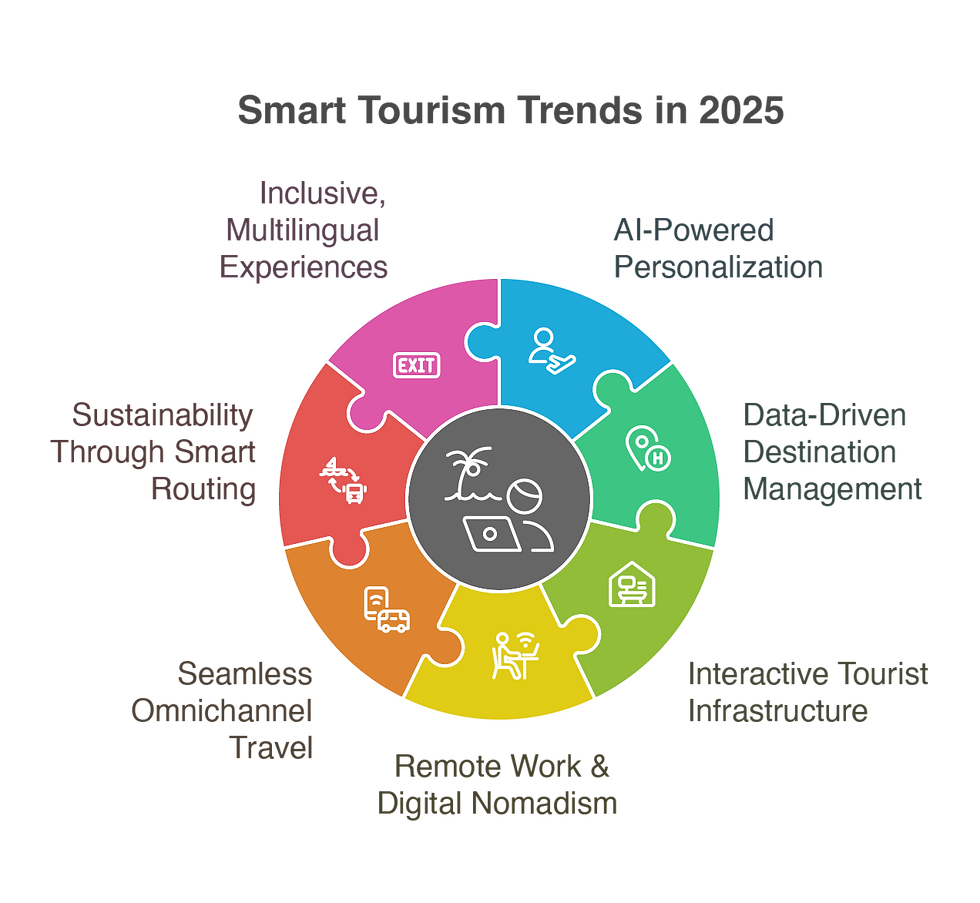What Cities Need to Know About the Future of Smart Tourism in 2025
- Chiara Verdi
- May 28
- 2 min read
Updated: Jun 9
The future of tourism is already unfolding. In 2025, travelers expect more than beautiful landmarks — they want seamless digital experiences, smart recommendations, and personalized content. Cities must respond with innovation. This article explores what defines smart tourism in 2025 and how platforms like Mira help municipalities rise to the challenge.
Why the Future of Tourism Depends on Digital Transformation
Municipalities worldwide are realizing that digital infrastructure isn’t a luxury—it’s a necessity. From interactive totems to real-time dashboards, technology enables cities to deliver frictionless travel experiences while collecting insights that guide smarter planning.
Cities that invest in digital transformation can:
Offer instant, personalized suggestions via AI travel assistants like Mira
Manage overcrowding with visitor flow analytics
Communicate with tourists in multiple languages
Promote local businesses based on location and interest
This strategic shift enhances both the visitor experience and long-term city development.

Personalization Is the New Expectation
One-size-fits-all tourism is officially outdated. Today’s travelers want experiences that reflect their interests—be it art, nature, history, or food. AI-powered platforms like Mira analyze behavior and preferences to deliver real-time, tailored recommendations.
By embracing this trend, cities can:
Appeal to niche audiences
Improve engagement and satisfaction
Encourage longer stays and repeat visits
This is more than convenience—it’s a shift in how people experience places.
Sustainability and Smart Routing Go Hand in Hand
The future of tourism isn’t just smart—it’s sustainable. With growing environmental awareness, travelers increasingly seek low-impact options. Cities can support this by using technology to guide tourists away from overcrowded areas and toward under-visited gems.
Smart platforms like Mira help by:
Offering eco-friendly route suggestions
Promoting local, sustainable businesses
Reducing print waste through digital content
Using energy-efficient digital infrastructure
This isn’t just green marketing—it’s long-term strategy.
Data-Driven Decision Making for City Planners
One of the most transformative aspects of smart tourism in 2025 is the ability to make decisions backed by real-time data. From foot traffic heatmaps to content engagement metrics, tourism authorities can gain deep insights without invading user privacy.
With these insights, municipalities can:
Improve public transportation routes
Adjust campaign strategies dynamically
Plan cultural events based on actual demand
Justify investments with real usage data
Platforms like Mira turn anonymous user data into strategic action.
Mira: A Ready-Made Solution for the Future of Tourism
Mira was built for cities that want to lead in the digital tourism era. Its all-in-one platform includes:
AI-powered content suggestions tailored to user preferences
Interactive multimedia totems for on-location discovery
A centralized dashboard for municipalities to track visitor behavior
Multilingual capabilities to support global audiences
Smart promotion tools for local businesses
Whether you’re managing a historic center or a coastal destination, Mira empowers your city to provide a future-ready experience that’s inclusive, intelligent, and impactful.
Conclusion
Smart tourism in 2025 goes far beyond new gadgets—it’s about reimagining how cities connect with travelers. It’s about blending culture with data, and tradition with technology.
Cities that act now to embrace digital transformation will not only stay competitive—they’ll help shape the future of tourism.
Mira is here to help you lead the way.


Comments